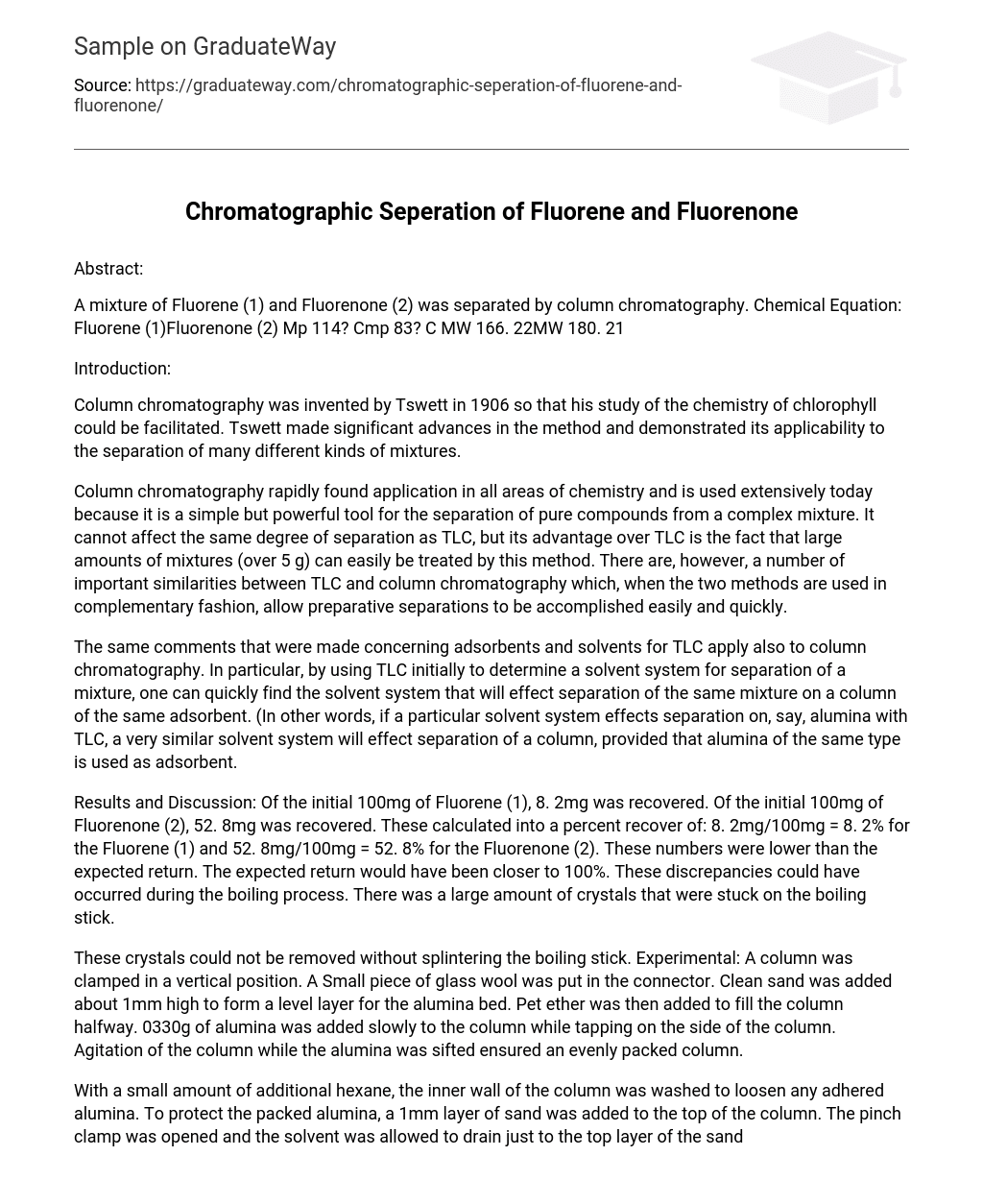Abstract:
A mixture of Fluorene (1) and Fluorenone (2) was separated by column chromatography. Chemical Equation: Fluorene (1)Fluorenone (2) Mp 114? Cmp 83? C MW 166. 22MW 180. 21
Introduction:
Column chromatography was invented by Tswett in 1906 so that his study of the chemistry of chlorophyll could be facilitated. Tswett made significant advances in the method and demonstrated its applicability to the separation of many different kinds of mixtures.
Column chromatography rapidly found application in all areas of chemistry and is used extensively today because it is a simple but powerful tool for the separation of pure compounds from a complex mixture. It cannot affect the same degree of separation as TLC, but its advantage over TLC is the fact that large amounts of mixtures (over 5 g) can easily be treated by this method. There are, however, a number of important similarities between TLC and column chromatography which, when the two methods are used in complementary fashion, allow preparative separations to be accomplished easily and quickly.
The same comments that were made concerning adsorbents and solvents for TLC apply also to column chromatography. In particular, by using TLC initially to determine a solvent system for separation of a mixture, one can quickly find the solvent system that will effect separation of the same mixture on a column of the same adsorbent. (In other words, if a particular solvent system effects separation on, say, alumina with TLC, a very similar solvent system will effect separation of a column, provided that alumina of the same type is used as adsorbent.
Results and Discussion: Of the initial 100mg of Fluorene (1), 8. 2mg was recovered. Of the initial 100mg of Fluorenone (2), 52. 8mg was recovered. These calculated into a percent recover of: 8. 2mg/100mg = 8. 2% for the Fluorene (1) and 52. 8mg/100mg = 52. 8% for the Fluorenone (2). These numbers were lower than the expected return. The expected return would have been closer to 100%. These discrepancies could have occurred during the boiling process. There was a large amount of crystals that were stuck on the boiling stick.
These crystals could not be removed without splintering the boiling stick. Experimental: A column was clamped in a vertical position. A Small piece of glass wool was put in the connector. Clean sand was added about 1mm high to form a level layer for the alumina bed. Pet ether was then added to fill the column halfway. 0330g of alumina was added slowly to the column while tapping on the side of the column. Agitation of the column while the alumina was sifted ensured an evenly packed column.
With a small amount of additional hexane, the inner wall of the column was washed to loosen any adhered alumina. To protect the packed alumina, a 1mm layer of sand was added to the top of the column. The pinch clamp was opened and the solvent was allowed to drain just to the top layer of the sand. A 100mg of the mixtures Fluorene (1) and Fluorenone (2) was added to the column. The solution was then eluted with pet ether and 50mL flasks were used as receivers.
The yellow color of Fluorenone (2) provided one index of the course of the fractionation, and the appearance of solid around the delivery tip provided another. The solid on the tip was frequently added to the receiver with pet ether. Once it was determined that one component was completely eluted, the receiver was changed when the second component began to appear. After it was determined that it was the 2nd component was being eluted, 1:1 pet ether-diethyl ether mixture was used until the column was exhausted. The solution of each flask was transferred to a pre-weighed vial.
The vial was then placed on a hot plate with a boiling stick to evaporate. Once the liquid was completely evaporated, the vials with the remaining crystals were weighed again to give percent yield.
References:
- “Techniques in Organic Chemistry”, J. R. Mohrig, C. N. Hammond, P. F. Schatz, W. H. Freeman and Co. , NY, 2006, p 116.
- “Chromatographic Separation of Fluorene (1) and Fluorenone (2)”, E. Kho, UHH, HI, 2009. “http://www. chemistry. adelaide. edu. au/cdrom/PracCDROM/2nd_Year/ChemIIE/Semester1/ChemIIE_Expt01. pdf”





